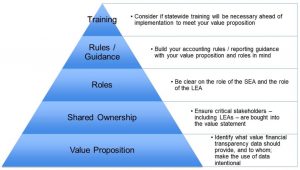One component of the Every Student Succeeds Act (ESSA) focuses on fiscal transparency and school-level financial reporting. This shift from current reporting practices requires states and districts to provide per-pupil expenditures of federal, state, and local funds for each individual school. This reporting will begin on state school report cards in Fall 2019 for the 2018-19 school year.
In February 2018, Afton Partners joined Edunomics Lab, the Building State Capacity and Productivity Center, and the Council for Chief State School Officers (CCSSO) who hosted a one-day conference for over 30 State Education Agencies (SEAs).
Afton led a session focused on how state agencies can play a role in fostering the usage of per-pupil financial data at the local level. In our session, members of state education agencies took on various roles within a district (teacher, principal, superintendent, parent, etc.) and reviewed a district’s site-level data from the lens of those roles. They looked at the data with questions in mind such as: “What do these data tell you? What more information do you need to play your role effectively?” The small groups convened as “districts” to discuss their data and then presented their site level data to neighboring districts.
Issues raised within the groups included:
- Equity. Participants pointed to various reasons why school per pupil data within the district could be driven by student-need factors, while acknowledging potential misunderstandings in the community if the data is not communicated properly.
- Context. Participants noted that more information is needed alongside the expenditure data to “tell the story.” Context such as student demographic information, teacher salary, and school-level outcomes would help in providing context for per pupil spending data.
- Improvement & Outcomes. Participants recognized how this kind of site-level data can produce value for resource allocation decisions, smart programmatic decisions, and trade-off decisions – given enough contextual data alongside the data.
As the group stepped back from playing the role of district stakeholder or staff member, we reflected on the role of State Education Agencies in fostering effective use of school site-based expenditure reporting. Our conclusion was that SEAs can do a lot to encourage effective use of this data, including training, issuing reporting guidance, clearly defining roles/responsibilities between state/local, and leading dialogue on the value of the reporting.

Afton sees the bottom component – value proposition – as a critical grounding mechanism from which all other work on this initiative at both the state and local levels build. Having this stated purpose of the reporting moves the reporting beyond simply a compliance requirement. It guides the way the reporting is developed, visualized, and explained, and focuses efforts to use this data as complementary to other school-level data already available. Afton believes ultimately that site-based expenditure reporting promotes:
- Transparency. Resource allocation will be more readily accessible to schools and stakeholders
- Equity. Empowers LEAs and communities to assess and improve equity (and possibly define equity for their community)
- Outcomes. Enables LEAs and communities to gain a better understanding of the relationship between student outcomes and financial resources
- Best Practices. Enables LEAs, schools, and the state to identify evidence-based best practices and opportunities to foster innovation between peers
For more information on the ESSA financial transparency requirement:
- AASA article “Coming Soon: Transparent School-by-School Spending”
- Education Next article “With New Data, School Finance is Coming Out of the Dark Ages”
- Georgetown University’s Edunomics Lab Financial Transparency Research